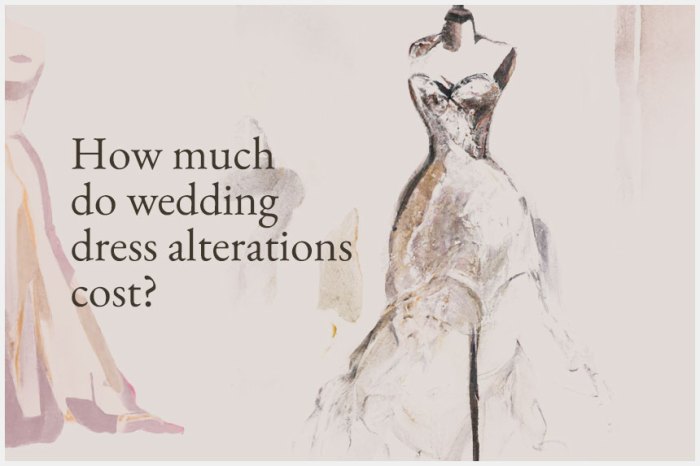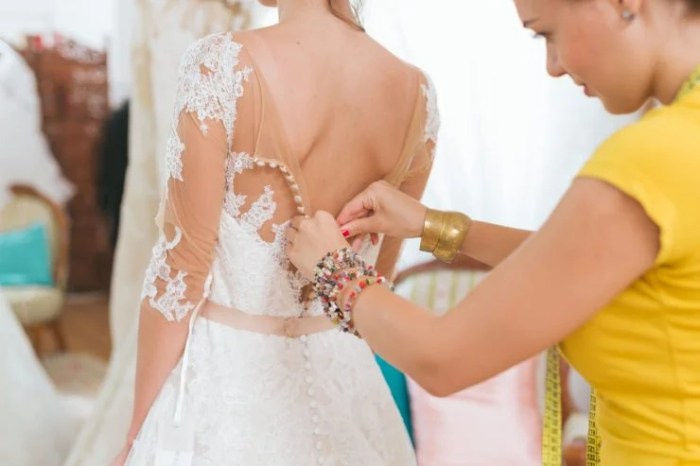Wedding Dress Alteration Costs: A Comprehensive Guide
How much are alterations for a wedding dress – The cost of altering a wedding dress can vary significantly depending on several factors. Understanding these factors is crucial for budgeting effectively and ensuring a smooth alteration process. This guide provides a detailed breakdown of the costs involved, helping you navigate the process with confidence.
Factors Influencing Wedding Dress Alteration Costs

Source: storyamour.com
Several key factors determine the final price of wedding dress alterations. These include the complexity of the dress design, the type and extent of alterations required, the experience and reputation of the tailor, and the geographic location of the alteration service.
| Factor | Low Cost Impact | Medium Cost Impact | High Cost Impact |
|---|---|---|---|
| Dress Complexity | Simple A-line gown, minimal embellishments | Fit-and-flare dress, some beading or lace | Intricate beading, layers of fabric, heavy embellishments |
| Type of Alteration | Hemming, bustle addition | Taking in seams, minor adjustments | Significant restructuring, adding sleeves, major design changes |
| Tailor Experience | Less experienced tailor, potentially lower hourly rate | Experienced tailor with a solid reputation | Highly sought-after specialist with extensive experience in bridal alterations |
| Geographic Location | Smaller town or city with lower cost of living | Medium-sized city with average cost of living | Major metropolitan area with high cost of living |
The designer of the dress and the fabric used also play a significant role. Designer gowns often require more specialized care and expertise, increasing alteration costs. Similarly, delicate or intricate fabrics like silk or lace demand more time and precision, leading to higher prices. Basic alterations like hemming or adding a bustle are generally less expensive than more complex alterations such as taking in seams or adding sleeves, which require more extensive tailoring.
Typical Alteration Types and Associated Costs, How much are alterations for a wedding dress
A wide range of alterations are commonly performed on wedding dresses. Understanding the typical costs associated with each can help you better estimate your total expenses.
- Hemming
- Bustle addition
- Taking in seams
- Let out seams
- Altering straps or sleeves
- Adding sleeves
- Altering neckline
- Adding or removing lining
- Lengthening or shortening train
- Replacing zippers or closures
- Repairing tears or damage
Alterations that involve significant restructuring, such as adding sleeves or significantly altering the neckline, are typically more expensive because they require more time, skill, and potentially additional fabric. Repairing intricate beadwork or lace also adds to the cost due to the delicate nature of the work.
| Alteration Type | Average Cost Range |
|---|---|
| Hemming | $50 – $200 |
| Bustle addition | $75 – $250 |
| Taking in seams | $100 – $400 |
| Adding sleeves | $300 – $800+ |
| Significant restructuring | $500 – $1500+ |
Finding and Choosing a Tailor
Finding a reputable tailor experienced in wedding dress alterations is crucial for achieving the desired results. Thorough research and comparison shopping are recommended.
Bridal boutiques often offer alteration services, providing convenience and a streamlined process. However, independent tailors may offer more competitive pricing and potentially greater flexibility. Getting multiple quotes from different tailors allows for price comparison and helps you assess the quality of service offered.
The Alteration Process: Timeline and Communication

Source: weddingandbridalinspiration.com
The alteration process typically involves several stages, from initial consultations to final fittings. Clear communication with your tailor is essential to ensure a smooth and successful outcome.
A typical timeline includes an initial consultation to discuss alterations, several fittings to ensure proper fit and adjustments, and final adjustments before the wedding day. Maintaining open communication throughout the process, clarifying expectations, and providing timely feedback are vital.
Sample Communication Plan:
Week 1-2: Initial consultation, discuss alterations and obtain a quote.
Week 3-4: First fitting, major adjustments made.
Week 5-6: Second fitting, fine-tuning and adjustments.
Week 7-8: Final fitting, ensuring perfect fit and addressing any last-minute concerns.
Wedding Week: Dress pick-up.
Budgeting for Alterations

Source: kxcdn.com
Budgeting for alterations is essential to avoid unexpected expenses. Accurate cost estimation requires careful consideration of the type and extent of alterations needed.
To estimate the total cost, create a detailed list of needed alterations and obtain quotes from several tailors. Include a contingency fund to cover unforeseen issues or adjustments.
| Budget Item | Estimated Cost |
|---|---|
| Hemming | $100 |
| Taking in seams | $200 |
| Bustle addition | $150 |
| Contingency Fund | $50 |
| Total Estimated Cost | $500 |
Illustrative Examples of Alteration Costs
The following scenarios illustrate the cost variations depending on dress style and required alterations.
- Scenario 1: Simple A-line gown. Alterations: Hemming, minor adjustments to the bodice. Estimated cost: $150 – $250. The visual impact is a perfectly fitted dress that enhances the wearer’s figure.
- Scenario 2: Lace mermaid gown with intricate beading. Alterations: Taking in seams, bustle addition, minor adjustments to the straps. Estimated cost: $400 – $700. The visual impact is a dress that hugs the body beautifully, with the beading and lace remaining intact and accentuated by the perfect fit.
- Scenario 3: Ballgown with a long train and substantial beading. Alterations: Hemming, bustle addition, significant alterations to the bodice and straps, minor repairs to some loose beads. Estimated cost: $700 – $1200+. The visual impact is a dress that drapes elegantly, with the intricate details enhanced by the precise alterations.
Questions and Answers: How Much Are Alterations For A Wedding Dress
Can I alter a sample dress?
Yes, but be aware that sample dresses may have been altered previously, potentially limiting further adjustments. Discuss this with your tailor beforehand.
What if I need alterations after the initial fitting?
Most tailors accommodate minor adjustments after the first fitting. However, significant changes might incur additional costs and time. Open communication is key.
How far in advance should I schedule alterations?
Ideally, begin the alteration process at least 8-12 weeks before your wedding to allow ample time for fittings and adjustments.
What payment methods do tailors typically accept?
The cost of wedding dress alterations varies greatly depending on the extent of the work needed. For instance, if you’re considering a simpler style for a daytime event, you might find inspiration browsing options like those found at dresses for a daytime wedding , which could influence the overall alteration price. Ultimately, the final cost of alterations will depend on the complexity of adjustments required to achieve the perfect fit.
Tailors generally accept cash, checks, and credit cards. Always confirm their preferred payment methods in advance.
